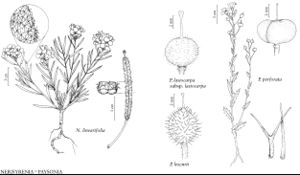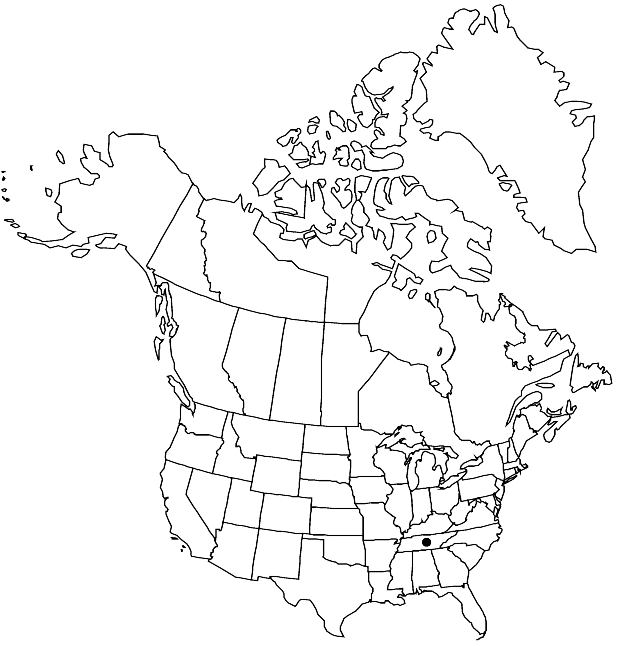Difference between revisions of "Paysonia perforata"
Novon 12: 381. 2002.
FNA>Volume Importer |
imported>Volume Importer |
||
| (3 intermediate revisions by 2 users not shown) | |||
| Line 11: | Line 11: | ||
|name=Lesquerella perforata | |name=Lesquerella perforata | ||
|authority=Rollins | |authority=Rollins | ||
| + | |rank=species | ||
|publication_title=Rhodora | |publication_title=Rhodora | ||
|publication_place=54: 190. 1952 | |publication_place=54: 190. 1952 | ||
| Line 39: | Line 40: | ||
-->{{#Taxon: | -->{{#Taxon: | ||
name=Paysonia perforata | name=Paysonia perforata | ||
| − | |||
|authority=(Rollins) O’Kane & Al-Shehbaz | |authority=(Rollins) O’Kane & Al-Shehbaz | ||
|rank=species | |rank=species | ||
| Line 54: | Line 54: | ||
|publication year=2002 | |publication year=2002 | ||
|special status= | |special status= | ||
| − | |source xml=https:// | + | |source xml=https://bitbucket.org/aafc-mbb/fna-data-curation/src/2e0870ddd59836b60bcf96646a41e87ea5a5943a/coarse_grained_fna_xml/V7/V7_1009.xml |
|tribe=Brassicaceae tribe Physarieae | |tribe=Brassicaceae tribe Physarieae | ||
|genus=Paysonia | |genus=Paysonia | ||
Latest revision as of 22:29, 5 November 2020
Annuals; pubescent, hirsute, or glabrate, trichomes simple, with branched, smaller ones. Stems erect, outer ones usually decumbent at base, 1–1.5 dm. Basal leaves: blade 2–5 cm × 5–15 mm, margins lyrately lobed, (lobes) entire or dentate, (lateral lobes broadly oblong, margins becoming remote basally, terminal lobes orbicular or ovate, apex obtuse to more pointed), surfaces hirsute (trichomes mostly simple, marginal ones branched, smaller). Cauline leaves: blade broadly oblong to nearly ovate, 0.8–2 cm × 4–8 mm, base auriculate, sagittate, margins dentate, (abaxial surface with simple and branched trichomes, adaxial surface hirsute, trichomes simple). Fruiting pedicels divaricate-ascending, straight, (scarcely swollen apically), 6–12 mm, uniformly pubescent (trichomes branched, or simple and branched). Flowers: sepals 3.5–5 × 1.5–2 mm, pubescent (trichomes relatively large and small, branched); petals white to pale lavender (with pale yellow claw, sometimes tinged light purple when dry), 7–9 × 5–6 mm, apex emarginate to rounded; filaments dilated basally, (anthers oblong, 1.3–1.5 mm, glandular tissue subtending all filaments, nearly surrounding those of single stamens, with projections between single and paired stamens). Fruits subsessile, broadly obovoid to subpyriform, (inflated, papery), 4–6 × 4 mm, (widest distal to middle); valves sparsely hirsute or glabrate outside, trichomes simple or branched, densely pubescent inside, trichomes dendritic; replum not flattened; septum perforated to nearly absent, consisting of a narrow rim; ovules 4–12 per ovary; style 1.5–2.5 mm, glabrous; stigma not or slightly expanded. Seeds suborbicular or orbicular, 1.2–2.5 × 1.2–2 mm. 2n = 16.
Phenology: Flowering Mar–May.
Habitat: Open fields, pastures, flood plains, roadsides
Elevation: 100-200 m
Discussion
Of conservation concern.
Paysonia perforata has a very limited distribution in Rutherford and Wilson counties. It is in the Center for Plant Conservation’s National Collection of Endangered Plants.
Selected References
None.

